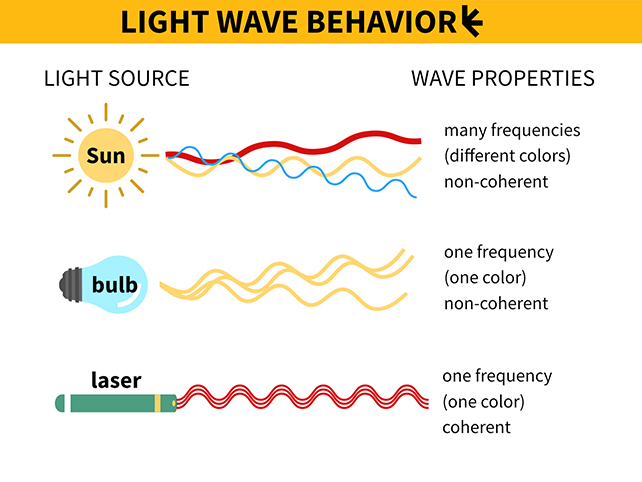Lasers are devices that concentrate beams of light by forcing their waveforms and frequencies to align. First developed in the 1960s to amplify microwaves, modern lasers technology can ramp up light rays in just about any part of the electromagnetic spectrum, with the exception of gamma waves.
The word stands for Light Amplification by Stimulated Emission of Radiation – which in a technical sense explains how lasers operate.
Though to be more precise, lasers today don't amplify the light – they oscillate the waves within the beam to arrange them in a neat and tidy order.
Swapping out the amplification for order (or, to be technical, 'oscillation') might be more accurate, but fewer people would want to entertain their cat with a 'LOSER' pointer.
So laser it is.
How do lasers do laser stuff?
The beating heart of lasers are materials that give parts of the electromagnetic spectrum a boost of energy as they pass through. This boost is referred to as 'gain', and can effectively amplify the light's power.
Behind this amplification is a process called stimulated emission. Atoms in the material are given a burst of energy (such as a high electric current), pushing their electrons into an excited state. Shining or reflecting light through this excited material causes the electrons to absorb and then emit their own photons.
In some lasers, this medium isn't a material made of atoms at all – just a bunch of electrons zipping about at speed.
Stuck inside a cavity that bounces the light around, the gain medium technically amplifies the amount of light shining through it. This is the fundamental basis of light amplification by stimulated emission.
While the amplification is a key part of the process, the feature that makes this the kind of laser we use to entertain cats, play DVDs, or shoot down star destroyers is something called coherence.

Light that passes through the gain medium all ends up the same color. Exactly the same. Identical wavelength, same direction, same polarization. Just a little more of it.
Sending the waves back-and-forth through the optical cavity then filters the beam, so what comes out are waves of the same phase. Every photon in this beam not only has the same characteristics, it oscillates in time with the crowd.
What's the most powerful laser ever made?
The most powerful laser designed to date can be found at the European Extreme Light Infrastructure facility in Romania. Its lasers are some of the most intense in the world, generating insanely brief pulses of photons, protons, neutrons, and neutrinos with incredible energy.
Its High Power Laser System uses a titanium-doped sapphire gain medium designed to generate laser pulses of up to 10 petaWatts.
Consider a watt is one joule of energy in a single second. For added context, it takes a little over 4,000 joules to heat a liter of water one degree Celsius.
A petaWatt is one quadrillion (1015) joules per second. Admittedly, the pulse is over in 22 femtoseconds (22 x 10-15 seconds), but that's still a decent amount of energy squeezed into a tiny fraction of a blink.
The record might not hold for very long, though. China's 'Station of Extreme Light' could knock it off its perch in coming years with emerging technology that could generate lasers of 100 petaWatts – a burst of energy so intense, it could shake empty space into producing a shower of particles in a display of physics of the likes we've never seen before.
All Explainers are determined by fact checkers to be correct and relevant at the time of publishing. Text and images may be altered, removed, or added to as an editorial decision to keep information current.
